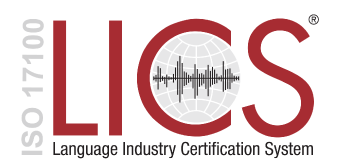From style guidelines to correct formatting, we can help you prepare your texts professionally for translation so that you get the best possible results.
What are the advantages of source texts that are written with translation in mind?
We’ve all been there: you revised your draft text, checked the spelling and grammar – but a mistake has still managed to slip through. It’s easily done, given that our main focus is on the content of the text. In addition, many modern companies employ an international workforce and, while English may be the corporate language, many English texts are no longer written by native speakers.
Seeing as errors in the source text affect the translation process and the quality of the translation, it is advisable to write the source text in a way that is conducive to translation and will facilitate the process. Rule-based writing allows the source texts to be optimized specifically for translation and localisation – this is why it is worth it to set rules for translation-oriented writing for your own editors and copywriters, as well as for external agencies. The following paragraphs outline the things to be considered when doing so.
Why is the quality of the source texts so important for translation?
Texts that serve as a basis for translation into several languages should be carefully checked before the start of the translation process, as the quality of the source text has a direct effect on the quality of the translation. Punctuation, spelling and grammar all need to be checked by means of traditional proofreading . As well as this, the style of the textneeds to be checked in relation to its genre and target audience:
- is the text suitable for a specialist audience or target group?
- Is the text likely to achieve its communication purpose, e.g. will it serve to increase sales of a new product?
- If you are dealing with operating instructions for a particular device, are they perfectly unambiguous and easy to understand?
Such criteria can be examined during proofreading or as part of a technical review. Uniformity must be ensured, especially in longer texts or documents that have been worked on by different authors:
- has the same technical terminology been used throughout?
- Does it contain spelling variants for particular words and number formats such as dates and units?
- Do they correspond to the conventions of the source language?
Anyone who is used to writing texts in English is likely to fall into the habit of writing numbers the English way, even when this is not appropriate – this is exactly the type of error that can have a negative impact on the translation process. For example, where English uses a decimal point, many other languages use a comma. Conversely, English uses a comma as a thousands placeholder, while German uses a period for this purpose – so if your numbers are not written in the correct format, you could end up with 1.234 instead of 1,234! In the worst case scenario, this is a serious error which could lead to property damage or personal injury. And because the number format was incorrect in the source language, the error will not be picked up by quality assurance functions in CAT tools. Sometimes even the translator can misinterpret such numbers.
Also, discrepancies in the technical terminology or spelling may result in a new text having a lower match rate with existing entries in the translation memory than would otherwise have been the case. To give a classic example, imagine the word “device” is used in the first edition of a user manual. During a later revision, some new standard sentences are inserted that have already been stored in the CAT tool. But this time the editor in charge decides to use the word “system” instead of “device” – this could lead to confusion, and would certainly reduce the probability of achieving high a match rate
Our tip: start by having your document translated into just one target language, and use the translation process as a quality control.
Translators are particularly adept at spotting discrepancies, which means that the translation process itself can contribute to quality control. However, this only makes sense if you translate your source text into just one language to start with, then optimize it before it is released for translation into multiple other languages. Translators pay very close attention to texts, so they tend to recognize unclear or inconsistent passages. Alternatively, some language service providers offer upstream quality assurance by an experienced expert reviewer, marketing editor or specialist translator. This is worth the effort, as it saves time and money by cutting down on subsequent queries and clarifications. Imagine, for example, 20 translators stumbling across the same error when translating the same text into 20 different languages.
How to optimize files for translation
Many clients, and even some language service providers, underestimate how important the quality of the source text is when if comes to ensuring a smooth translation process. No client wants to invest unnecessary resources in answering time-consuming queries or in post-editing completed translations. Language service providers and translators also want to complete the translation project as efficiently as possible using their chosen CAT tool. This is why optimizing texts for translation is worthwhile for all parties involved, especially the client.
File optimization and using translation-friendly writing techniques are important prerequisites for automatic translation, in which the CAT tool accesses previously translated texts and translates the new text automatically. Since the CAT tools do not have any inherent sense of text logic, such processes are only suitable for source texts that have been specifically written for translation, typically with shorter sentences and simpler structures. For these processes you also need to ensure that the data contained in the translation memory is of sufficiently high quality. There are many types of text for which automatic translation is entirely unsuitable – especially where any errors that slip through undetected could have serious consequences for users or the environment.

Download our Guideline: How to prepare your content for translation
From style guidelines to correct formatting, this guide will help to prepare your texts professionally for translation so that you get the best possible results.
CAT tools offer many advantages for the translation process. However, good source texts are a prerequisite for optimum segmentation, i.e. the sentence-by-sentence division of the text within the CAT tool, which is triggered by certain punctuation marks such as a period or colon. Also, to make best use of the quality assurance functions built into the CAT tool, date and number formats must be used correctly and consistently. Good file preparation includes the following criteria:
Removing wraps:
- Remove hard line breaks (paragraph marks) in the middle of a sentence.
- Remove soft line breaks (Ctrl+Enter) at the end of a sentence.
- Remove manual page breaks.
- Remove manual hyphenation.
Using consistent number formats:
- Use the correct number formats for the source language.
- Use the correct date and time formats for the source language.
Optimizing the formatting:
- Use tabs instead of spaces for indentations.
- Remove superfluous formatting (including fonts and font sizes).
- Remove superfluous review comments.
In addition to these formal criteria, we recommend that source texts undergo a quality assurance review to avoid subsequent queries, as well as undesirable effects in the CAT tool. First, the text must be correct and complete. Note that an incorrect source text in the CAT tool database will prevent potential 100% matches – this means that typos add unnecessarily to the cost of a translation. The same applies to inconsistent terminology and spelling; as a customer, you should set out rules for spelling and terminology in your corporate language guidelines for the source language, for example in an editorial guide or in style guide. This will help you to avoid match rates being lower than they could be due to the increasing inclusion of new variations, such as inconsistent use of hyphenation with long words.
The same applies to the translation, by the way. Translators and project managers will be grateful if your foreign subsidiaries also define the style and terminology requirements for the target languages and markets for which the translation is needed. Your language service provider will be happy to help you create a style guide or glossary tailored to your company’s specific needs. This investment will definitely pay off, because it will enable you to significantly reduce your post-processing costs and leave your employees free to concentrate on their core tasks.
Why are style guides important for copywriting and translation?
Text uniformity is an important prerequisite for high match rates. Technical terms, spelling, formatting and style should be as consistent as possible. This includes aspects such as:
- Numbers and units of measurement
- Date formats
- The use of hyphens in compound words
- Extended product names
- Orthographic standardization, where legitimate spelling alternatives exist.
Because even the most minor discrepancies will quickly reduce the number of 100% matches, which will increase the cost of the translation. So it pays to provide your editors with a style guide and to write your source texts with the translation in mind.
For the same reason, as well as producing a style guide, it is also advisable to provide a glossary of technical terminology. Many companies have recognized that the effort they put into creating terminology glossaries is well worthwhile. Editors can refer to them as they write, and they help to ensure that everyone in the company – whether in marketing, development, product management or sales – speaks the same language. It will also help suppliers of high-quality products and services to impress their customers. It is equally important to standardize the spelling of product and company names, as these usually have legal ramifications which need to be considered.
Why style guides are important for the translation process
If you already use a corporate editorial or style guide, you will be aware of how many corrections or queries you can save in-house by adhering to them. The same applies to the translation process. By equipping your language service provider with excerpts from your editorial guides or style guides, you can significantly reduce the amount of time and effort your organization spends on post-editing translations. If you already have a clear idea about how your corporate language for the target markets should look and sound, then let your language service provider know. This will enable them to ensure that the translations fully meet – or even exceed – your expectations. You will also have fewer queries to respond to and less post-processing work to do, which will save you time and money.
Is your company among those that use English terms in product names? Or do you use English for all your job titles? If so, then you should inform your language service provider of this when you order a translation. Do not rely on the translator chancing on the “right” reference material while researching the job. Use your style guide or glossary to provide clear guidelines. Everyone involved in the translation process will benefit from this, and you will save time and effort by avoiding the need for post-editing and corrections!

Download our Guideline: How to prepare your content for translation
From style guidelines to correct formatting, this guide will help to prepare your texts professionally for translation so that you get the best possible results.













